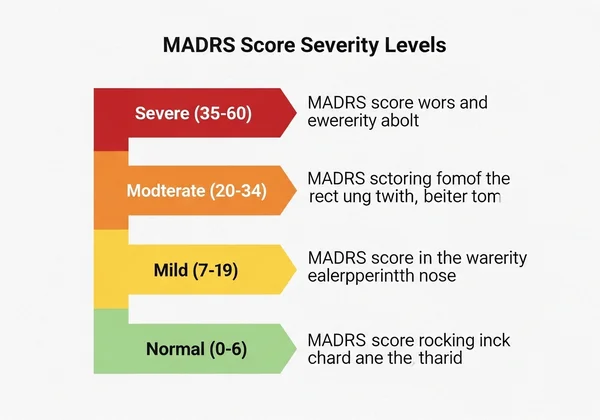MADRS Score: Next Steps & Doctor Visit Guide
Receiving your MADRS score can feel like a significant moment. You've taken a step to understand your emotional state, and now you have a number in front of you. But this often leads to a crucial question: What do I do with this information? Whether your score is low, moderate, or high, it's a valuable piece of data. Think of it not as a final verdict, but as a starting point—a compass to help you navigate your mental health journey. This guide is here to walk you through the essential next steps, from interpreting your results to preparing for a conversation with a healthcare professional.
Understanding your score is the first step toward empowerment. This information can help you articulate your feelings and experiences more clearly. If you haven't yet, you can get your MADRS score by taking the confidential and clinically-trusted Montgomery-Åsberg Depression Rating Scale assessment. The goal is to turn this number into meaningful action and a productive dialogue about your well-being.
Understanding Your MADRS Score: Next Steps
Once you have your score from a MADRS assessment, the immediate priority is to understand its context. This number is a clinical snapshot of your symptoms over the past week. It isn't a label, but rather a tool to measure the severity of depressive symptoms. Let's break down how to begin making sense of it.

What Does Your MADRS Score Mean? (Interpretation Overview)
Your MADRS score provides a quantitative measure of depression symptoms. The scale ranges from 0 to 60, where a higher number indicates more severe symptoms. Each of the 10 questions on the test evaluates a specific aspect of depression, such as apparent sadness, inner tension, or sleep disturbances. The total score aggregates these individual ratings into a single, comprehensive figure.
This score is highly valued in clinical settings because it helps professionals gauge the intensity of a depressive episode. It’s a standardized way to translate subjective feelings into objective data. For you, this means you have a powerful tool to understand your own emotional state and communicate it effectively. Remember, the free MADRS test is designed to provide this initial insight securely and quickly.
Is Your MADRS Test Score Normal? Ranges & Severity
A common question is, "What is a normal MADRS score?" In a clinical context, "normal" typically refers to the absence of significant depressive symptoms. The scores are generally broken down into severity levels, which provide a clearer picture of where you stand. While specific ranges can vary slightly by clinical guidelines, a widely accepted interpretation is:
- 0-6: Normal / Symptoms Absent. You are likely not experiencing significant depressive symptoms.
- 7-19: Mild Depression. Symptoms are present but may not be significantly impacting daily functioning.
- 20-34: Moderate Depression. Symptoms are more pronounced and likely interfere with work, social, or personal life.
- 35-60: Severe Depression. Symptoms are intense and cause considerable distress and impairment in daily functioning.
Seeing a score in the mild, moderate, or severe range is a clear signal that it's time to seek professional guidance. It provides a solid foundation for your first conversation with a doctor or therapist. It's important to know that these ranges are for informational purposes. Only a qualified healthcare provider can provide an accurate diagnosis.

Preparing to Discuss Your MADRS Score with a Doctor
Bringing your MADRS score to a doctor is one of the most proactive steps you can take for your mental health. This single piece of data can streamline your conversation, making it more focused and productive. A doctor can use your personal MADRS score as a baseline to understand your situation and recommend the best course of action.
Key Information to Bring to Your Appointment
To make the most of your visit, a little preparation goes a long way. Your MADRS score is an excellent starting point, but complementing it with other information will give your doctor a holistic view. Before your appointment, consider jotting down notes on the following:
- Your MADRS Score: Bring the exact number and, if possible, your answers to the individual questions.
- Symptom History: When did you first start noticing these feelings? Have they been constant or do they come and go?
- Daily Impact: How have these symptoms affected your sleep, appetite, work, relationships, and hobbies?
- Current Medications: List all medications, supplements, and vitamins you are currently taking.
- Personal and Family History: Note any personal or family history of mental health conditions.
Having this information ready helps your doctor understand the full context of your score. It transforms the number from an abstract data point into a personal story, enabling a more accurate and empathetic assessment.

Effective Communication Tips for Your Doctor's Visit
Talking about mental health can be daunting, but you are not alone. Doctors and mental health professionals are trained to have these conversations with compassion and expertise. To facilitate a clear dialogue, try these communication strategies:
- Be Direct: Start the conversation by saying something like, "I took an online depression screening called the MADRS, and my score was [your score]. I'm here to discuss what this means and what my next steps should be."
- Use Your Notes: Refer to the information you prepared. It's easy to forget important details when you're feeling anxious.
- Be Honest: Share the full extent of your feelings, even if it feels uncomfortable. Your doctor needs a complete picture to help you effectively.
- Ask Questions: Don't hesitate to ask for clarification. Good questions include: "Based on this score, what are your thoughts?", "What are the possible next steps?", and "What resources are available to me?"
Your visit is a partnership. Your role is to provide the information, and your doctor's role is to provide the expertise. The MADRS online assessment is simply the tool that helps bridge that conversation.
After a High MADRS Score: What to Expect Next
Receiving a high MADRS score, particularly in the moderate to severe range, can be unsettling. However, it's also a critical turning point that can lead to effective support and treatment. A high score is not a destination; it's a signpost pointing you toward the path of recovery. Knowing what to expect can help demystify the process and reduce anxiety about the future.
Common Recommendations for Depression Management
After reviewing your MADRS score and discussing your symptoms, a healthcare professional will explore potential treatment options with you. It's crucial to understand that this is a collaborative decision. A provider will not diagnose you based solely on a screening tool, but will use it as part of a comprehensive evaluation. Some common recommendations might include:
- Further Evaluation: This could involve a more in-depth diagnostic interview or additional screening tools to rule out other conditions.
- Psychotherapy: Often called "talk therapy," this involves working with a therapist (like a psychologist or counselor) to develop coping strategies.
- Medication: Antidepressant medication may be recommended to help manage chemical imbalances in the brain associated with depression.
- Lifestyle Adjustments: Recommendations often include changes to diet, exercise routines, sleep hygiene, and stress management techniques.
Your doctor will tailor a plan that is right for you. The journey to feeling better is a process, and the first step is seeking that professional consultation.
The Role of MADRS in Tracking Treatment Efficacy
The value of the MADRS doesn't end after your initial assessment. In fact, it is a clinical "gold standard" for monitoring progress over time. Your doctor may suggest you retake the MADRS assessment periodically—for instance, every few weeks or months—to track how your symptoms are responding to treatment. This is where a tool like our MADRS online tool becomes incredibly useful for ongoing self-monitoring.
By comparing your scores over time, you and your doctor can see objective evidence of your progress. A decreasing score is a strong indicator that your treatment plan is working. If your score remains stagnant or increases, it signals that adjustments may be needed. Using the MADRS to track your progress empowers you to take an active role in your recovery, making the entire process more transparent and collaborative.
![]()
Moving Forward: Your MADRS Score and Mental Well-being
Your MADRS score is more than just a number—it's a catalyst for change. It's a concrete piece of information that can bridge the gap between feeling unwell and seeking help. By understanding what your score means, preparing for a productive conversation with a doctor, and recognizing the role of ongoing monitoring, you are taking a powerful and courageous step on your journey to improved mental well-being.
Remember, this tool is here to support you, not define you. Let it be the starting point for a new chapter in your mental health journey. If you're ready to take that first step or want to monitor your progress, we invite you to use the free and confidential MADRS test on our website.
Frequently Asked Questions About Your MADRS Score & Next Steps
How do you interpret MADRS scores?
MADRS scores are interpreted based on a 0-60 point scale that measures the severity of depressive symptoms. A score of 0-6 is generally considered within the normal range, 7-19 suggests mild depression, 20-34 indicates moderate depression, and a score of 35 or higher points to severe depression. This scoring system helps individuals and clinicians objectively assess symptom intensity.
What is considered a high MADRS score?
A high MADRS score is typically one that falls into the moderate (20-34) or severe (35-60) ranges. A score in this territory indicates that symptoms are likely having a significant negative impact on your daily life and functioning. It is a strong indicator that you should consult with a healthcare professional for a comprehensive evaluation and to discuss potential treatment options.
Can I use MADRS for self-assessment, and is it accurate?
Yes, you can absolutely use the MADRS for self-assessment. Tools like the MADRS online test are designed to provide an accurate, reliable snapshot of your current symptoms based on the clinically validated scale. While it is highly accurate for screening and monitoring, it is important to remember that it is not a diagnostic tool. An official diagnosis can only be made by a qualified healthcare provider.